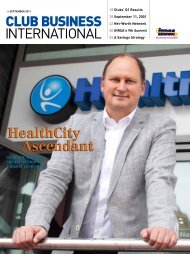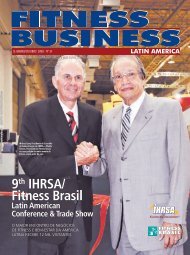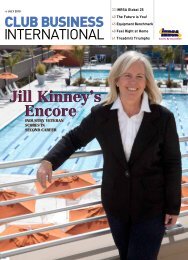Augie In Action! Augie In Action! - Ihrsa
Augie In Action! Augie In Action! - Ihrsa
Augie In Action! Augie In Action! - Ihrsa
Create successful ePaper yourself
Turn your PDF publications into a flip-book with our unique Google optimized e-Paper software.
WELLNESS NOTION<br />
“<strong>In</strong> the mid-1980s, a hospital built a cardiac rehabilitation<br />
center off of one of our gyms and would make use of it<br />
several days a week,” Stauble recalls. “<strong>In</strong> another case, in<br />
1983, there was a physical therapy facility adjacent to one<br />
of our clubs—we shared equipment and learned that side<br />
of the business.”<br />
From those experiences, Healthtrax developed “the second<br />
generation of a medically-affiliated fitness center<br />
in a large medical building.” Each community wellness<br />
center, typically situated in a relatively affluent suburb with<br />
a population of about 100,000, consists of a two-story Class<br />
A medical office building with a large central atrium that<br />
allows plenty of sunlight to shine down from the second<br />
IS THERE A DOCTOR IN THE CLUB?<br />
How operators can forge a medical connection<br />
It’s true that the medical community focuses on cures and<br />
treatments, while the health club industry favors a more<br />
preventative approach. But the reason that most doctors<br />
are hesitant to refer their patients to health clubs is not—<br />
contrary to popular belief—because they’re afraid they’ll<br />
lose their livelihood, according to Bob Stauble, the director<br />
of new business and sales for Healthtrax Fitness and<br />
Wellness, in Glastonbury, Connecticut. Having worked<br />
closely with hospitals and doctors for nearly three decades,<br />
he’s learned that it’s not competition that they fear, but,<br />
rather, the unknown.<br />
“To their credit, doctors are just so busy—barely getting<br />
through their 11-minute appointments, getting their<br />
prescriptions right, giving all of their advice—that it’s hard<br />
for them to make use of everything that’s available in<br />
healthcare today,” he explains. “They just don’t know what<br />
to expect out there in health clubs, which aren’t regulated<br />
the way traditional healthcare providers are. They don’t want<br />
to refer their patients to a fitness center and then<br />
have them get hurt. If that happens once, they may stop<br />
referring their patients to gyms—period.”<br />
So how can club operators remedy this situation?<br />
One way is to invite a group of doctors to participate in a<br />
medical advisory board or focus group, Stauble suggests.<br />
Give them a membership, introduce them to your club’s<br />
services, and ask them to meet occasionally to provide<br />
feedback on the business. “If they come and see your<br />
systems and procedures firsthand, that’s a huge plus.<br />
There’s no easy solution to physician referrals, but that<br />
helps a lot.”<br />
To operators interested in establishing a formal business<br />
relationship with a hospital or medical practitioner, Stauble<br />
advises, “You really want to convey the notion that you enhance<br />
their core business—not that you’re a new additional business<br />
component. Make sure they understand that, by aligning with<br />
your club, they don’t have to change their business plan.”<br />
86 Club Business <strong>In</strong>ternational | MARCH 2008 | www.ihrsa.org<br />
floor. A 35,000-square-foot<br />
Healthtrax fitness center<br />
typically occupies most of<br />
the first floor, sharing space<br />
with some clinical offices,<br />
while the upstairs houses<br />
the offices of doctors and<br />
other medical professionals.<br />
The building itself is<br />
usually constructed by a<br />
third-party developer, who<br />
owns the real estate and<br />
acts as landlord to all of Bob Stauble<br />
the tenants. <strong>In</strong> most cases,<br />
Healthtrax seeks out a hospital partner to attach its name<br />
to the building, thus extending its brand presence beyond<br />
its own medical campus and increasing its market share<br />
in the community.<br />
Together, the hospital and Healthtrax offer a construction<br />
project that presents the most appeal to a developer. “The<br />
benefit to the developer is that, between the hospital and<br />
Healthtrax, the building is almost preleased,” Stauble notes.<br />
“And, if a hospital can bring a 100,000-square-foot project<br />
to a developer, instead of a 50,000-square-foot one, they can<br />
probably get a better deal on development costs and rent by<br />
going with the bigger project.”<br />
“A medical affiliation helps<br />
your credibility, and it appeals<br />
to the kind of member<br />
who’s not interested, or<br />
comfortable, in a traditional<br />
club setting.”<br />
Once the community wellness center has been constructed,<br />
Healthtrax sets out to strike up cooperation agreements, or<br />
strategic partnerships, with its various neighbors.<br />
“The agreement spells out the myriad ways in which<br />
we might cooperate, in terms of cross-referrals and doing<br />
marketing together,” Stauble explains. “We might even share<br />
some of our amenities. For example, a therapy operation<br />
might ask to use our pools during certain hours.”<br />
Differentiation, referrals, profits<br />
Today, Healthtrax Fitness and Wellness represents the<br />
only fitness business model of its kind—which gives it a<br />
measurable advantage over nearby health clubs.<br />
“Being a differentiated fitness center leads to more<br />
profits,” Stauble points out. “When you’re not competing<br />
head-to-head with traditional gyms and health clubs, then
















